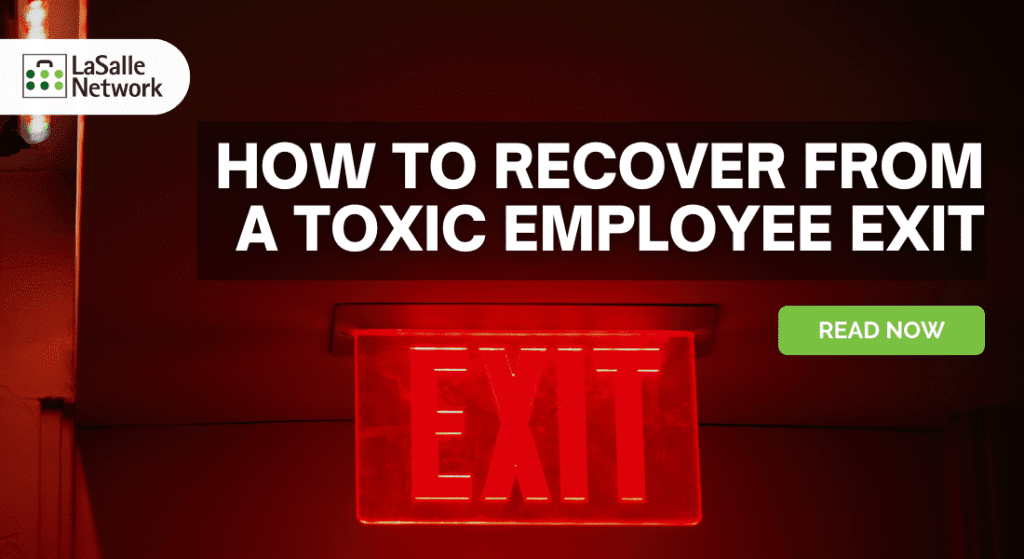If you’re adding talent to your team, let us help. Get connected with us here.
There have been a lot of changes recently in the world of work, with unemployment reaching all-time lows, predictions of a recession impacting some business’ hiring decisions, many large tech companies undergoing layoffs, and more. With a shifting economy comes shifting employee needs and emerging workplace trends – and we did the research for you on how to support and retain talent throughout it all. Download our latest report today.
A potentially damaging trend carrying over from 2022, Quit-toks, showcase social media users quitting their jobs publicly, trashing their employer, and posting it for all to see. As resignations continue across the U.S., we’re sharing how managers on the receiving end of these and other toxic employee exits can recover, and what to consider when interviewing someone with a history of Quit-toks.
How to Recover from a Toxic Quitter
1. Damage Control
Uncomfortable or dramatic resignations can leave a lingering impact on a team. Especially if the former employee told teammates their plan to quit or frequently complained prior to their exit, it is important to debrief what happened with the team as quickly as possible.
Even if unsure about who on the team knows what happened, honesty is often the best policy. Rumors spread quickly, and addressing the toxic quit directly with the team can help correct a false narrative. If appropriate, apologize for what happened and the uncomfortable position the team was put in, and direct employees to Human Resources for additional support if needed.
Toxic quitting can damage the team’s morale. Especially if the disgruntled employee complained heavily to peers or made accusations of wrongdoing by management, they could have impacted their peers’ opinion of the team and management as well. Consider setting up one-on-one meetings with employees to check in and conduct stay interviews – getting the teams live feedback.
2. Seek Support
Check pride at the door. While the toxic quit could feel like a personal affront, depending on the complaints of the former employee, avoid taking it personally and reach out to management for support. Being honest about what happened, what was said, and what the employee’s complaints were can help mitigate the effects of the quit quickly.
If needed, ask for feedback or support from peers about how to prevent this from happening again. Without spreading gossip, discussing potential solutions with peers can help prevent a repeat occurrence.
3. Avoid Bitterness
Especially if this toxic quit came from an employee who was heavily invested in, or came without warning, it may cause hesitation when investing in the growth of other employees. Don’t let getting burnt by one employee detract from the relationship building and investment in others. Investing in growth and development is key in reengaging employees, and just because one employee did not feel loyalty to the organization after being invested in, does not mean others won’t.
How to Evaluate a Quit-toker
So a resume for the ideal candidate with unique, in-demand skillsets and a proven track record slid across the desk…but a quick skim of their social media displays the worst. Or maybe a quick reference call to a former employer uncovers the candidate left their prior role with a rather disgraceful exit. Should they still be considered for the role?
1. Evaluate the Candidate
Evaluate first the open job as compared to its current available talent pool. If the role requires specific, hard-to-find skillsets or the candidate’s accomplishments seem to outweigh their negativity, they may still be worth pursuing. However, if their resume is just one in a stack of many, the risk of them repeating toxic behaviors may not be worth any further consideration.
2. Dig Deeper
If considering them for the role, be sure to ask their references about their professional demeanor and attitude, as frequent complaining from even one team member can take a toll on the overall team’s morale. If their exit was toxic, chances are the candidate’s poor attitude may have emerged in other areas as well. Consider the overall potential damage done to the person’s prior team, and how they may bring that over to a new role, or if it may have been a result of a poor environment.
3. Address the Issue
If still interested in the candidate, consider addressing these concerns with them during the interview. Without being accusatory, ask them to explain from their perspective what happened and why they chose to react in that way.
If choosing to move forward and extend an offer to the candidate, do so with care. Work to keep an open line of communication with them as they begin the job, and make sure they know what processes to go through to ask for help or communicate concerns to avoid a repeat of their last toxic quit.
Let us help you find quality talent. Get connected with us today.




